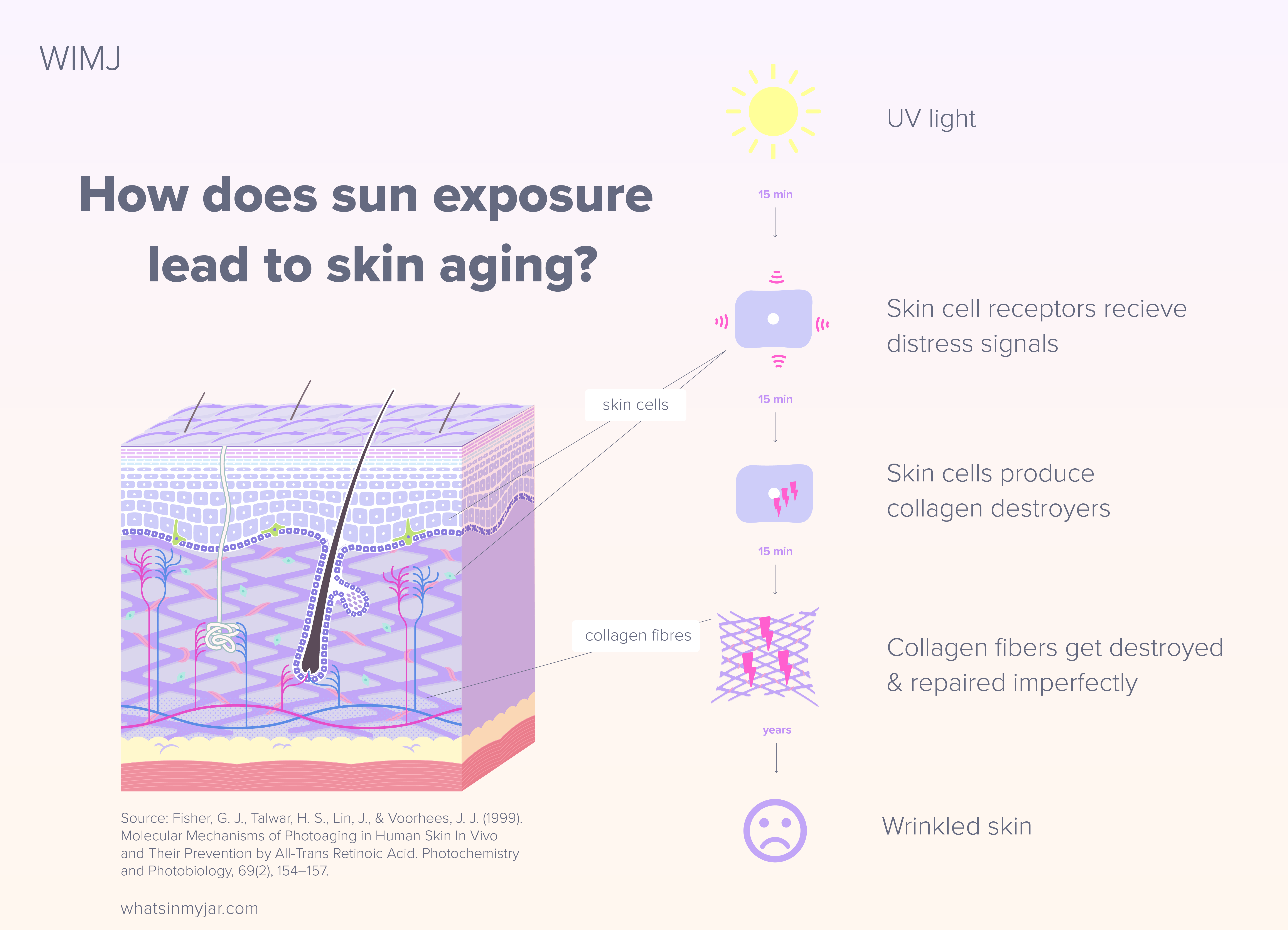The Ultimate Guide to Sunscreens and Sun Protection
Understanding why sunscreen is important in skincare is essential for maintaining youthful, healthy skin. Scientists have found that a staggering 80% of externally-caused skin aging is a result of sun damage. The effects? A variety of skincare woes such as pigmentation problems, scarring, and enlarged pores as we age. So, whether you’re dealing with anti-aging, acne, or pigmentation concerns, sunscreen is an irreplaceable part of your skincare routine. And remember, it’s vital for all skin tones – yes, even the darkest ones.

Sunscreen also helps prevent skin cancer. To achieve both health and beauty goals, your sunscreen must be broad-spectrum, protecting against both UVA and UVB rays, with an SPF factor of 30 or higher. Apply sunscreen every time you step outdoors or sit near a window lacking UV filters, even on cloudy days.
Sun damage builds up over time. The sooner you start applying sunscreen daily, the healthier and younger your skin will look in the future.
It’s also important to shield children’s skin from sun damage, as it significantly affects their skin health and appearance later in life.
How does sunlight cause skin aging?
How can something as pleasant and warm as sunlight be harmful? What exactly does UV radiation do to our skin that results in wrinkles and a loss of elasticity?
Here’s the main process. UV light activates cell receptors in both the epidermis (the upper layer) and the dermis (the deeper layer) of our skin. This activation begins within 15 minutes of sun exposure and lasts at least 2 hours afterwards.
These activated receptors start receiving distress signals from outside the cells. This occurs within 30 minutes of sun exposure and continues for a full 24 hours. These signals trigger enzymes inside the cells, which then produce specific proteins. These proteins’ role is to “clean up” a site of skin damage. This clean-up process involves breaking down collagen fibers in the skin.
A single exposure to UV light results in a significant increase in production of these collagen-destroying proteins. Their concentration only returns to normal 48-72 hours after sun exposure.
After the old collagen fibers are destroyed, skin cells produce new collagen. But this repair process isn’t flawless. The new collagen matrix is less robust than the old one, and this degradation continues with each new sun exposure. Dermatologists refer to this process as “solar scarring”. Over time, UV exposure leads to an accumulation of these solar scars, resulting in photoaged, wrinkled skin.

Sun light & skin: UVA and UVB explained
The sun emits various types of light, including ultraviolet (UV) light. When we talk about “sun protection” or “sunscreen”, we’re really talking about shielding our skin from this UV light.
How does light affect our skin? It all comes down to the wavelength. Shorter waves carry more energy, but they only skim the surface of our skin. Longer waves have less energy, but they can penetrate deeper into our skin.
Based on their wavelengths, we divide UV light into three types: ultraviolet light type A (UVA), ultraviolet light type B (UVB), and ultraviolet light type C (UVC). UVC rays are the shortest, most potent, but least penetrating. In contrast, UVA rays are the least potent but penetrate the deepest. Thankfully, our ozone layer absorbs UVC rays, stopping them from reaching the Earth’s surface and harming our skin.
But UVB and UVA rays do make it through. High-energy, short-wavelength UVB rays can cause immediate damage to our skin, leading to sunburn and direct DNA damage in our epidermis (the top layer of our skin). Such damage can trigger skin cancers and aging.
UVA rays are a different story. They’re longer and less potent, so they won’t cause immediate visible damage like a sunburn. But their longer waves can dig deeper into our skin, harming the dermis—the layer that holds our skin’s collagen and elastin fibers. That’s why we sometimes call UVA rays the “UV-Aging” rays, unlike the “UV-Burning” UVB rays. While UVA rays don’t directly harm our DNA, they indirectly damage it by creating free radicals. These free radicals can cause skin aging (think wrinkles, age spots, loss of elasticity), inflammation, and DNA damage, thereby increasing the risk of skin cancer.
So, our skin needs protection from both UVB and UVA rays. Keep in mind that not all sunscreens shield against both types of rays. Until recently, most sunscreen filters only protected significantly against UVB rays. But over the past few decades, scientists have been hard at work developing new filters for sunscreens that offer broad-spectrum protection—meaning they protect against both UVB and UVA rays. These newer filters are now widely used in sunscreens around most of the world. Unfortunately, an exception is the US, where most of these new-generation filters have yet to receive FDA approval and thus aren’t included in sunscreens sold here – at least, officially.
Sunscreen filters for UVB rays
UVB rays are infamous for causing sunburn, skin cancer, and speeding up skin aging. The distinguishing factor for UVB rays is their wavelength, which falls between 290 and 320 nanometers. This makes UVB rays shorter than UVA rays, so they don’t penetrate our skin as deeply as UVA rays. However, UVB rays carry more energy, meaning they can directly damage skin cells, particularly their DNA.
Here are some common UVB filters found in sunscreen:
- Titanium dioxide
- Octocrylene
- Homosalate
- Octinoxate
- Oxybenzone
- Uvasorb HEB (not yet approved by the US FDA)
- Uvinul T (not yet approved by the US FDA)
Along with these UVB filters, certain broad-spectrum filters provide excellent protection from both UVB and UVA rays. Some of these include:
- Mexoryl SX
- Zinc oxide
- Mexoryl XL (not yet approved by the US FDA)
- Tinosorb M (not yet approved by the US FDA)
- Tinosorb S (not yet approved by the US FDA)
Sunscreen filters for UVA rays
UVA rays are culprits in causing premature skin aging, leading to wrinkles, loss of elasticity, and age spots. They’re also known to trigger hyperpigmentation, like post-acne marks and melasma. It’s worth noting that the so-called “healthy tan” is a result of UVA ray damage. These rays even contribute to skin cancers.
UVA light has a wavelength between 320 and 400 nanometers. Not every sunscreen filter covers this entire UVA range. That’s why it’s helpful to divide the UVA spectrum into UVA I (the longest UVA waves, from 340 to 400 nanometers) and UVA II (shorter UVA waves, from 320 to 340 nanometers). We are typically exposed to more UVA I range light. However, the longer UVA I rays are more difficult to protect against. That’s why a sunscreen filter is typically classified as UVA if it protects against these longer UVA I rays.
In general, UVA waves penetrate human skin more deeply than UVB rays because they’re shorter. However, UVA rays carry less energy and don’t directly damage skin cell DNA like UVB rays. Nevertheless, they still cause DNA damage indirectly by creating free radicals, leading to chemical reactions harmful to skin health.
Even when it’s cloudy, UVA light reaches the Earth’s surface and can penetrate glass windows. Therefore, protection is always necessary.
Here are some popular UVA or broad-spectrum filters used in sunscreen. All listed below protect against long UVA I rays, while broad-spectrum filters protect against both UVA and UVB light:
- Zinc oxide
- Mexoryl SX
- Avobenzone
- Mexoryl XL (not yet approved by the US FDA)
- Tinosorb M (not yet approved by the US FDA)
- Tinosorb S (not yet approved by the US FDA)
Mineral vs. organic sunscreen filters
Sunscreen filters come in two types, based on their chemical nature. The first type is non-organic or mineral filters. These include only Zinc Oxide and Titanium Dioxide. These are called mineral or non-organic because their molecules don’t contain carbon atoms, as you might remember from high school chemistry. Note that this has nothing to do with “organic farming”. These non-organic or mineral sunscreens are also sometimes confusingly called “physical” sunscreens.
Mineral sunscreen filters are typically gentle on the skin, making them ideal for sensitive or reactive skin types, and even babies and children. They don’t cause eye stinging. Also, they’re stable, meaning they don’t degrade quickly when exposed to sunlight. This makes it easier to formulate minimum-ingredient sunscreens with them: they do not require additional “stabilizers” and UV protection helpers in the formula.
However, mineral sunscreens also have their downsides. The main issue is their cosmetic appeal. These filters require a thicker texture to work effectively and often leave a white to grey, chalky finish on the skin, which can be unattractive for darker skin tones. Recently, sunscreen formulators have managed to create more aesthetically pleasing products using finely milled and coated zinc oxide particles. According to research, these finely milled mineral filters are safe for the skin and the body in general.
Another problem is that mineral filters aren’t the most potent. For example, 10% nano Zinc Oxide provides an average SPF of about 5 without additional sunscreen boosters. 10% Titanium Dioxide offers an SPF of about 20 but leaves a very noticeable white cast. Plus, Titanium Dioxide can’t provide sufficient protection from the long UVA I rays.
All-in-all, creating a mineral-only sunscreen with high UVB and UVA protection that also works cosmetically for daily use is quite challenging. Most such products provide around SPF 30.
What about organic or “chemical” sunscreens? There are dozens of these compared to the two non-organic ones, making it harder to generalize. Some early organic sunscreen filters, like Oxybenzone, Sulisobenzone, and PABA, often cause irritation, while others, like Tinosorb M and S and Homosolate, have a lower irritation risk. Some “chemical” filters are unstable, like Avobenzone, while others, like the new-generation filters such as Mexoryls and Tinosorbs, are very stable. The best UVA protectors come from the organic sunscreen group.
Generally, new-generation filters outperform earlier organic filters in broad-spectrum protection, efficiency, and stability. They can also rival the safety of mineral products when formulated well.
However, many new-generation organic sun filters are not approved by the FDA, meaning they’re unavailable in the US, despite being used safely in Europe and Asia for decades.
Lastly, some sunscreens are marketed as mineral but still contain organic actives that function as UV filters, such as Butyloctyl Salicylate. It’s not officially recognized as a UV filter, but it does protect in the UVB range. There’s nothing inherently wrong with it, and it rarely causes sensitivity. However, calling a sunscreen with it “mineral” can be seen as slightly misleading.
New generation sunscreen filters
New-generation sunscreen filters refer to compounds specifically designed for skin protection. Most were developed and tested in the 90s and 2000s. These filters are generally stable, offering reliable protection within their range. Sunscreens that include these filters often outperform those with older ones. However, despite being safely used in Europe and many other regions, the US FDA has been slow to study and approve these new compounds. US consumers can still often access products with these filters through international shipping or other FDA loopholes.
Here’s a list of new-generation filters:
- Tinosorb S
- Tinosorb M
- Tinosorb A2B
- Uvinul T
- Uvinul A Plus
- Ensulizole
- Uvasorb HEB
- Amiloxate
- Mexoryl XL (available in L’Oréal Group brands like La Roche Posay & Garnier)
- Mexoryl SX (also available in L’Oréal Group brands)
Sunscreen filters to avoid for sensitive skin
If you have sensitive skin, certain sunscreen ingredients can be more likely to cause irritation. These common irritants in the UV filter category don’t necessarily cause problems for everyone, but if you experience a reaction to a sunscreen, they could be the culprits:
- Octinoxate (also known as Ethylhexyl Methoxycinnamate)
- Oxybenzone (also known as Benzophenone-3)
- Amiloxate (also known as Neo Heliopan E1000 or Isoamyl p-Methoxycinnamate)
For skin that is very reactive, or prone to eczema and other chronic conditions, a fragrance-free mineral sunscreen is often the safest choice. These are also the best options for babies.
Protection from visible & infrared light
Compared to UVB and UVA rays, visible light has the longest wavelength. This means it has less energy, but can penetrate deeper into the skin. Visible light splits into colors, depending on the wavelength. The shortest visible light waves are blue. Blue light is closest to UV radiation in terms of its effect on the skin. This is why you often hear about blue light specifically in skincare conversations. Red light, with the longest wavelengths and least energy in the visible spectrum, is at the other end. Infrared light comes next in the light (radiation) spectrum. Its waves are longer than red light’s (meaning less energy, but deeper penetration). We don’t see infrared radiation, but we feel it as warmth.
Visible and infrared light (heat) can create free radicals in the skin, potentially contributing to skin aging. These types of light can also trigger skin pigmentation. However, it’s important to remember that the damage they cause is significantly smaller than that caused by UVA and UVB rays. Therefore, UVA and UVB protection should be your primary skincare focus. Only when you’ve got this well covered should you consider protecting against visible light and heat.
Practically protecting your skin from visible light is tricky. Only optically opaque materials can do it, meaning any cream that protects against visible light would be noticeable on your skin. Heavy white zinc oxide pastes can offer visible light protection, but they leave a noticeable white layer. The sunscreen filter Tinosorb M can also provide some protection in the visible spectrum, but it too leaves a visible white layer. This is where tinted sunscreens and makeup come in: opaque foundations can protect from visible radiation. This protection usually comes from iron oxides that give a sunscreen or makeup its tint. The heavier or fuller coverage a tinted product provides, the more protection against visible light it can offer.
Many skincare products claim to protect against visible or blue light. However, what they usually mean is that they offer some protection from the free radicals generated by it, not the light itself.
It’s also worth noting that the main source of blue and other visible light is the sun, not device screens. While screens do emit blue light, the amount is negligible compared to daily exposure to visible light from the sun.
In conclusion, it’s true that blue and other types of visible light, as well as infrared radiation (heat), can contribute to skin aging and pigmentation. However, their effect is much smaller than that of UV light. Also, protecting from visible light might not always be practical. If you’re diligently protecting your skin from UV rays, you’re already making a big difference for your skin’s health and beauty. Protection from visible light, while beneficial, isn’t as crucial (although wearing a tinted sunscreen or foundation can be a plus).
Positive effects of UV and other radiation on skin
Sunlight, different types of visible light, and other types of radiation can have therapeutic effects on the skin. Skin biology is complex, and things that affect biological processes in the skin often have both positive and negative effects. A qualified dermatologist can determine if the benefits of UV, light, or other types of therapy outweigh the side effects in your specific case.
The devices used in these treatments are designed to emit only certain wavelengths. In contrast, the sun emits a wide range of radiation, and you can’t control what reaches your skin. These treatments are also brief and target specific areas of the skin. The risks of exposing your skin to UV, light, and other forms of radiation without control and supervision almost certainly outweigh any potential benefits.
UVB radiation initiates the synthesis of Vitamin D in our skin. However, studies show that daily sunscreen use does not lead to Vitamin D deficiency.
Best Sunscreen Search
Take your sun protection to the next level. Find sunscreens with matt finish, minimal white cast, sunscreen sprays and sticks. Browse mineral-only sunscreens. sunscreens for babies, for sensitive skin, sunscreens with new generation filters such as Tinosorb S and Tinosorb M.
Sources
-
Human Safety and Efficacy of Ultraviolet Filters and Sunscreen Products https://www.derm.theclinics.com/article/S0733-8635(05)00112-9/fulltext
-
UV Filters: Challenges and Prospects https://www.mdpi.com/1424-8247/15/3/263
-
Fisher, G. J., Talwar, H. S., Lin, J., & Voorhees, J. J. (1999). Molecular Mechanisms of Photoaging in Human Skin In Vivo and Their Prevention by All-Trans Retinoic Acid. Photochemistry and Photobiology, 69(2), 154–157. Fisher, G. J.
-
Talwar, H. S., Lin, J., & Voorhees, J. J. (1999). Molecular Mechanisms of Photoaging in Human Skin In Vivo and Their Prevention by All-Trans Retinoic Acid. Photochemistry and Photobiology, 69(2), 154–157. doi:10.1111/j.1751-1097.1999.tb03268.x
-
Sunscreens: An overview and update https://www.sciencedirect.com/science/article/abs/pii/S0190962210000228
-
Metal oxide sunscreens protect skin by absorption, not by reflection or scattering https://pubmed.ncbi.nlm.nih.gov/26431814/
-
Porcia B. Love, Roopal V. Kundu. Clinical Cases in Skin of Color https://link.springer.com/book/10.1007/978-3-319-22392-6
-
Medical, Oncological and Hair Disorders, and Cosmetic Dermatology https://link.springer.com/book/10.1007/978-3-319-23615-5
-
Jackson-Richards D, Pandya AG. Dermatology Atlas for Skin of Color https://link.springer.com/book/10.1007/978-3-642-54446-0
-
Effects of Visible Light on the Skin https://onlinelibrary.wiley.com/doi/full/10.1111/j.1751-1097.2007.00286.x
-
Cutaneous Interaction with Visible Light: What Do We Know https://www.sciencedirect.com/science/article/abs/pii/S019096222030551X
-
An overview of sunscreen regulations in the world https://www.researchgate.net/profile/Giulio-Pirotta-2/publication/283515177_An_overview_of_sunscreen_regulations_in_the_world/links/563cdb7508aec6f17dd7e0d6/An-overview-of-sunscreen-regulations-in-the-world.pdf
Related Articles
Winter Skin Care: Navigating the Chilly Season with Healthy Skin
Let’s dive into understanding winter skin and how to best care for it.
The Dark Side of Lightweight Sunscreens
Do lightweight sunscreens provide enough sun protection? Lightweight sunscreen formulas have a higher risk of not providing the sun protection they promise. Learn more in this article.
Opting for Fragrance-Free Skincare: A Skin-Friendly Choice
Opting for Fragrance-Free Skincare: A Skin-Friendly ChoiceIs the smell of your skincare products hurting your skin? It's a question we often don't think about. Yes, the scents can be nice, but they can also cause problems. About one in three skin issues from cosmetics...
What Does Sensitive Skin Mean and How to Help It?
Discover what sensitive skin truly means. We break down the causes, symptoms, and potential triggers of sensitive skin, and share simple steps to manage and reduce skin sensitivity effectively.
Do You Really Need Custom-Made Skincare?
Custom-made skincare products have become a talking point recently. But are they an essential innovation in skincare or simply a captivating marketing gimmick? This blog post delves into whether personalized skincare truly offers advanced scientific solutions tailored to our unique needs or is it luring us into paying more for seemingly “perfect” products.
Is Skincare A Scam?
Is Skincare a Scam? "Is skincare a scam?", you might wonder after spending $$$ on products that don't work. Or better put, "does the beauty industry turn skincare into a scam?". In many ways, yes - unfortunately. As consumers, we crave innovation, seeking skincare...
Do I Need Sunscreen for Indirect Sunlight?
How often have you heard that sunscreen is key for protecting our skin from the sun? A lot, right? But, does this same rule apply when you’re in indirect sunlight, in the shade or on a cloudy winter day? The answer is yes. Here’s the explanation.
The Ultimate Guide to Skin Cleansing
Daily skin cleansing is an essential part of skincare, but do we truly understand why we cleanse our skin and how it works? How often should we wash our skin? Let’s dive deep into the world of skin cleansing and clarify the typically overlooked basics.
How to Choose A Good Moisturizer?
Choosing the right moisturizer for your skin can be a daunting task. The market is awash with countless products, each promising to hydrate, protect, and nourish your skin. So, how do you make an informed choice? Let’s break down the evidence behind effects of moisturizers, debunk marketing myths, and learn how to choose the best moisturizer for your skin.
How Many Steps Do You Really Need for A Good Skincare Routine?
What Steps Do You Really Need for A Good Skincare Routine?Taking care of your skin is more than just a beauty routine - it’s an important part of maintaining overall health. But skincare can be overwhelming, with so many products and steps to choose from. While there...




